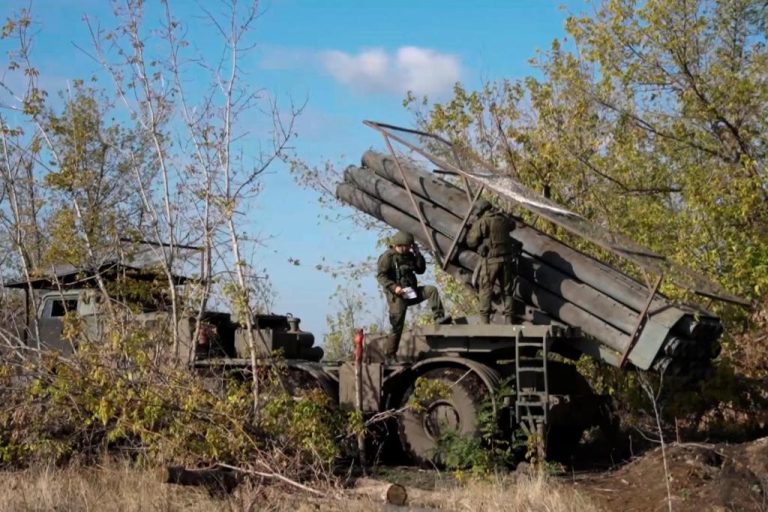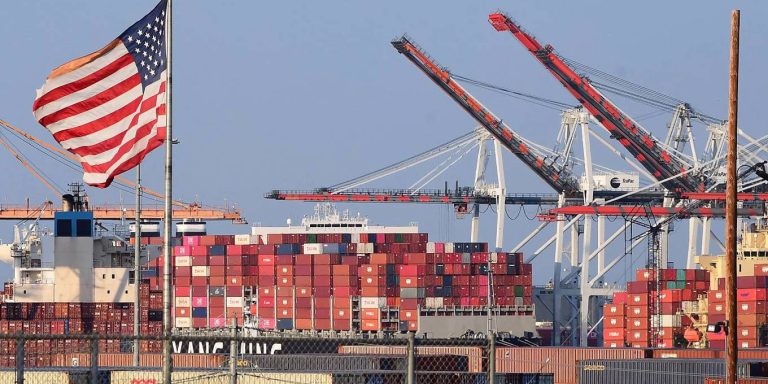Every day, Nayeli arrives for work at a meat-processing plant in rural Tennessee – the same place where, on the morning of 5 April 2018, federal agents swept in, helicopters buzzing above, and took her and nearly 100 other workers into custody, as part of the Trump administration’s then escalating crackdown on illegal immigration.
They were rounded up and put on buses without the opportunity to explain who they were or how long they had worked there, she said. Many were sent to out-of-state detention centers. Nayeli was among those released that evening, allowed to return home to her son, who was nine at the time. All faced deportation.
Last year, the immigrant workers won a rare settlement in a class-action lawsuit against the US government and federal agents, who they accused of racial profiling and excessive use of force. After a year without work, Nayeli returned to her job at the plant, Southeastern Provision, located in the small, lakeside town of Bean Station. She says she is moving forward with her life in Tennessee, where she now helps organize her community as part of a local immigrant rights coalition.
But that day in April still haunts her. She fears it could happen again, to her and other immigrants if Donald Trump were to return to power.
“I am afraid that he may win, because I have heard that he wants deportations,” she said. “I am very scared of this.”
Raids and mass deportations lie at the heart of the former president’s second-term vision – a web of policies so vast that critics say their collective implementation would challenge the very ideal of the United States as a nation of immigrants.
Should he win in November, the Republican nominee has vowed not only to restore many of his most controversial immigration policies, but to go even further. While a number of his first-term plans were stymied by the courts and Congress, immigration rights leaders believe a second Trump administration would likely be more sophisticated and strategic.
“It is different this time. There’s a plan. There is a sense of urgency that they’ve created around this issue,” said Vanessa Cárdenas, executive director of the immigration advocacy group America’s Voice. “And they know how to use the levers of government in a way they didn’t in 2016.”
Trump would also be operating in a changed political landscape. Since leaving office, the political center of gravity has shifted rightward, amid a post-pandemic rise in global migration that saw a record number of people arriving at the southern border and claiming asylum. Americans have become less tolerant of illegal immigration while a growing minority is increasingly concerned about its impact on the country’s economy and national identity.
Though border crossings have plummeted this year following the president’s asylum clampdown, a sense of disorder persists. Voters continue to broadly disapprove of the Biden-Harris administration’s handling of the situation. Trump and his team are confident immigration remains a potent political issue for voters – and one that he has long played to his advantage.
When Trump first descended a golden escalator in 2015, he pledged to construct a “great wall” along the south-west border with Mexico to keep out immigrants he disparaged as “rapists” and drug dealers. Now, in the final weeks of his third presidential race, Trump has again escalated his threats against immigrants, but this time he is turning his vitriol inward toward those already here.
“The United States is now an occupied country,” Trump claimed recently at a rally in Atlanta. “But on November 5, 2024, that will be liberation day in America.”
‘Not just the bad people’
Trump has vowed to stage the “largest deportation operation in American history”. The former president repeats the pledge so frequently, it has become a campaign rallying cry. At the Republican national convention in Milwaukee this summer, his supporters waved signs that read “Mass deportations now!” and chanted: “Send them back.”
Trump has offered few concrete details about his plans, but in public remarks and interviews, he and his allies, including Stephen Miller, the architect of Trump’s harsh immigration agenda and an influential adviser, have sketched out an expansive vision that dovetails with the plans laid out in Project 2025, a 900-plus page presidential transition blueprint led by the rightwing Heritage Foundation. The strategy, as Trump has described it, may involve the extraordinary use of US troops for immigration enforcement and border security and the application of 18th-century wartime powers.
Trump has likened his mass deportation plan to the campaign carried out under President Dwight D Eisenhower in 1954. Known by the ethnic slur “Operation Wetback”, hundreds of thousands of people with Mexican ancestry, including some US citizens, were rounded up and deported. Trump’s ambition is vastly more draconian, immigration advocates say.
As he has sought to return to the White House, Trump has pledged to expel “maybe as many as 20 million” people from the US, though he often fails to distinguish between those who are in the country unlawfully and those who have legal residency.
There were 11 million undocumented immigrants living in the US as of 2022, the vast majority of whom had been in the country for more than a decade. It is estimated that more than 2 million new arrivals encountered at the southern border since Biden took office remain in the country. Hundreds of thousands of immigrants granted permission to temporarily live and work in the US for humanitarian reasons are also vulnerable and could see their status revoked.
“The totality of it is to be so cruel and to make life so hard for immigrants today that they are left with two options: stay in the United States and be subject to presidential demagoguery … or leave their lives here, no matter how long they’ve been here, and go someplace else,” said Todd Schulte, the president of FWD.us, an immigration advocacy group.
To speed up the process, Trump has said he could invoke the archaic Alien Enemies Act of 1798, which allows for summary deportation of non-citizens from a foreign country with which the US is at war. In his rationale, he would use it “to target and dismantle every migrant criminal network operating on American soil”, though it remains an open legal question as to whether the supreme court would allow a president to apply the law in this manner. His plans also include the construction of enormous detention camps that Miller, who is expected to serve in a second Trump White House, has declared would be “greater than any national infrastructure project we’ve done to date”.
“I want everybody to understand this is going to happen,” Miller told rightwing activist Charlie Kirk on his podcast last year. “If President Trump is back in the Oval Office in January, this is going to commence immediately.”
Beyond a deportation operation, Trump has vowed to “terminate” every one of Biden’s “open-borders” policies. He says he would reinstate a policy requiring people seeking asylum in the US to remain in Mexico while their claims are processed and would again invoke the emergency health authority, known as Title 42, that allows US officials to turn away asylum seekers at the border.
His platform calls for reinstating a version of his controversial ban on travel from several primarily Muslim countries, which Biden called “a stain on our national conscience” and ended on his first day in office.
Allies have circulated legal theories to support ending birthright citizenship for the US-born children of undocumented immigrants, a proposal most scholars believe to be unconstitutional. Trump has also stated that he would impose ideological screenings to keep “Christian-hating communists, Marxists and socialists out of America”. The visas of foreign students who participated in anti-Israel or pro-Palestinian protests could be rescinded.
Courts have held that presidents have wide latitude to act on immigration. An emboldened Trump, with a deadlocked Congress, could dramatically reshape the immigration system, especially by restricting legal pathways. “The president’s authority there is far more powerful because it is not as much a question of resources as it is a question of policy,” said Aaron Reichlin-Melnick, senior fellow at the American Immigration Council, a non-profit advocacy group.
In a statement, Karoline Leavitt, a Trump spokesperson, blamed the Biden-Harris administration for creating an “unprecedented immigration, humanitarian and national security crisis on our southern border”.
“President Trump will restore his effective immigration policies, implement brand-new crackdowns that will send shockwaves to all the world’s criminal smugglers, and marshal every federal and state power necessary to institute the largest deportation operation of illegal criminals, drug dealers and human traffickers in American history,” she said.
Trump recently previewed aspects of his sprawling agenda at a rally held in Aurora, Colorado – hardly a presidential battleground but a convenient backdrop to stoke fears of suburban America under siege. Aurora residents and its Republican mayor forcefully rejected Trump’s portrayal of the city as a “war zone” overrun by Venezuelan gang members, but it had no effect.
Read more from the series
Flanked by mugshots on stage, Trump announced “Operation Aurora”. The crowd roared. A second Trump administration would unleash “elite squads” of federal law enforcement officers to “hunt down, arrest and deport every last illegal alien gang member until there is not a single one left in this country”. He also called for the death penalty for “any migrant” who kills an American.
But the dragnet would be turned on anyone in the country unlawfully. JD Vance, his running mate, has suggested a “sequential approach” beginning with people who have committed crimes, before expanding to all undocumented immigrants, and even those with legal but temporary status designated for people fleeing war, violence and other crises in their home countries.
At a campaign stop in Arizona this month, Vance deflected a question about whether a future administration would deport Dreamers – young adults who arrived in the US as children, hundreds of thousands of whom are currently shielded from deportation by the Deferred Action for Childhood Arrivals (Daca) program that Trump attempted to terminate during his first term.
“We also have to deport people, not just the bad people who came into our country, but people who violated the law coming into this country,” Vance told reporters. “We’ve got to be willing to deport them.”
Logistical and economic challenges
Analysts say such an operation would face enormous logistical, legal and bureaucratic challenges, making it virtually impossible to achieve in the span of a four-year presidential term.
“Any president who dreams of one grand operation to round up 11 million people is probably fooling themselves,” Reichlin-Melnick said.
Carrying out 1m deportations per year, as Vance has suggested, could cost $967.9bn over a decade, according to an analysis by the American Immigration Council published this month. Congress would have to provide a major infusion of resources, to hire tens of thousands of new government employees and law enforcement officers and greatly expand the capacity of detention facilities and immigration courts, Reichlin-Melnick said.
Assuming a Republican-controlled Congress was willing to allocate the funds, the new cases would land in an already-overwhelmed immigration court system: there is currently a backlog of nearly 3.7m unresolved cases, according to Trac, a research group at Syracuse University.
Sudden, large-scale deportations would fracture families – both citizens and noncitizens – deeply rooted in their communities. As many as 4.4 million children who are US citizens live with a parent who is undocumented, according to the Pew Research Center.
Lisa Sherman Luna, executive director of the Tennessee Immigrant and Refugee Rights Coalition, recalls children returning home from school to empty homes after their parents had been arrested in the 2018 workplace raid. The following day, more than 500 students were reported absent from school, as fear and confusion spread.
“It was like a bomb had gone off in this little community,” she said. Teachers scrambled to comfort students, as advocates and faith leaders scrambled to set up a crisis response center. Sherman Luna recalled a sense of shock, even among residents whose families had not been directly affected.
“What we discovered in Morristown was that the local community, including many non-immigrant, native Tennesseans, were really appalled by what happened,” she said. “I remember clearly one of the women who had lived in Tennessee her whole life said: ‘You know, I voted for Trump, but I never imagined that this would be the impact of that.’”
The economic toll could also be jarring. Researchers say mass deportations at the scale Trump is proposing risk exacerbating labor shortages and driving up inflation. The American Immigration Council report estimated that his mass deportation plan would shrink the country’s gross domestic product by 4.2% to 6.8% – a level not seen since the Great Recession. Tax collections would also fall: in 2022, undocumented immigrants contributed nearly $100bn in federal, state and local taxes.
About 8.3 million US workers were unauthorized immigrants as of 2022, according to Pew, roughly 5% of the overall workforce. They contribute to the economy by creating demand for goods and services such as cars, food and haircuts. In a study of the labor market impact of more than 450,000 deportations between 2008 and 2013, the researchers found that scaling up enforcement did not improve the overall employment share and wages of US-born workers. Rather, it reduced them, particularly for low-skilled Americans.
“The idea that large-scale deportation is good for Americans has proven to be an illusion in the past and is an illusion now,” Michael Ettlinger, a senior fellow at the Carsey School of Public Policy at the University of New Hampshire, told reporters.
Undocumented people often fill low-wage jobs that native-born workers won’t take, particularly in industries such as construction, agriculture, caregiving and service. Americans were especially grateful for their contributions during the pandemic, as millions of undocumented people worked frontline jobs, risking their health to provide essential services.
During an hour-long Univision town hall with undecided Latino voters earlier this month, Trump fielded a question from Jorge Velázquez, a farmworker from California who said he had spent years picking strawberries and cutting broccoli in the fields. Many of those workers were undocumented, he said. He wanted to know Trump’s plan to fill those jobs if those workers were deported, and what that might mean for food prices.
After a stream of falsehoods about immigrants coming from countries that were “emptying out” jails and “mental institutions” – and no mention of his mass deportation plan – Trump stated that he supported legal immigration.
“We want workers, and we want them to come in, but they have to come in legally, and they have to love our country,” Trump said. His campaign did not provide details on how he might do so.
Fear-inducing rhetoric and ‘chilling effects’
In the final weeks of the presidential campaign, Trump’s nakedly xenophobic rhetoric has grown ever more menacing and nativist. Impervious to facts, he has falsely blamed undocumented people for the country’s woes, including inflation, urban crime and a dearth of federal funding for disaster response. “They’re ruining the fabric of our country,” Trump said at a rally in Walker, Michigan, presenting mass deportations as a cure-all.
He has even pre-emptively identified non-citizens as the culprit if he doesn’t win in November, amplifying baseless claims that noncitizens are voting en masse. It is part of broader rightwing conspiracy theory that Democrats are allowing immigrants to flow into the country unlawfully so that they will vote and steal the election from him. (Noncitizen voting is illegal and extremely rare.)
Last month, Trump said removing undocumented immigrants from the country “will be a bloody story”. He had previously echoed Adolf Hitler, when he said undocumented immigrants were “poisoning the blood of the country”.
In a recent interview, Trump accused those who have come to the US of having “bad genes” that predispose them to commit violent acts, distorting a federal statistic in service of a groundless claim that undocumented people have driven up crime rates. And at a rally in Arizona last week, Trump likened the US to a “garbage can for the world” as he railed against a “migrant invasion” of the country.
“We have got to get those animals out of here fast,” he said of immigrants who have committed crimes. (Many studies have found that immigrants – whether they have legal status or not – tend to be more law-abiding than US-born citizens.)
“Trump has managed to dehumanize us on such a scale that people forget – when they think about immigration, they don’t think of a person anymore. They think of a wall,” Michelle Ming, the political director of United We Dream Action, a youth-led immigrant rights group.
In recent months, Trump has targeted local communities such as Aurora. But perhaps no community has been more affected by Trump’s latest campaign to demonize immigrants than Springfield, Ohio. From the presidential debate stage, he repeated a debunked conspiracy theory about Haitian immigrants stealing and eating their neighbors’ pets. Almost immediately, threats began pouring in, leading to school closures and forced evacuations. The city canceled its annual celebration of cultural diversity due to safety concerns.
Ohio’s Republican governor pleaded with Trump to stop spewing the meritless claim, but the Republican ticket doubled down. Vance, the state’s senator, said he would not stop referring to the Haitian immigrants as “illegal aliens” even though most of them are in the country lawfully, having escaped political turmoil and repression.
“They have no values to unite Americans, no policies to move the nation forward,” said Patrick Gaspard, the chief executive of the Cap Action Fund, the political arm of the liberal thinktank the Center for American Progress, who is Haitian-American. “So instead they rely on the oldest play in the book – the play that authoritarians always summon, which is hatred, fear, division and terrorism.”
Fear was central to Trump’s first term. Advocates say even just the threat can lead to broad “chilling effects”. After his election in 2016, households with undocumented family members began to carefully plan routine outings, said Wendy Cervantes, the director of immigration and immigrant families at the Center for Law and Social Policy (Clasp). A person with legal status would grocery shop for the entire family. Undocumented parents agonized over whether to take their children to a doctor’s appointment. Some immigrants disenrolled from public benefits they or their US-citizen children were eligible for, wary it could lead to their removal.
“I saw families putting signs up on the front door at the kids’ eye-level saying: ‘Don’t open the door,’” Cervantes recalled. “The climate of fear creates toxic stress, which is harmful for the entire family and in particular children.”
During Trump’s term, his immigration policies were broadly unpalatable. But advocates worry in a noisy election cycle with voters concerned about border security, the sheer intensity of Trump’s immigration agenda has been dulled.
Surveys have found increasing public support for mass deportation of undocumented people. A national Scripps News/Ipsos poll showed that 54% of respondents agreed either “strongly” or “somewhat” with Trump’s plan, including a quarter of Democrats.
But when provided with details about Trump’s plans, especially as they relate to long-settled undocumented people, a survey by the University of Maryland’s Program for Public Consultation (PPC) found that majorities of voters in six swing states and nationally strongly preferred offering them an earned path to citizenship to mass deportations.
“If large-scale removals of undocumented immigrants, in fact, begins to happen, it will affect all Americans because, inconveniently, undocumented people do not live in an apartment building all by themselves,” said Angela Kelley, a senior policy adviser with the American Immigration Lawyers Association. She added: “It’s a warning that really all Americans should take seriously.”
As Kamala Harris seeks the presidency, she has attempted to project toughness on the southern border while making the case that a second Trump term would inflict even more harm on immigrant communities.
At a Venezuelan restaurant in Doral, Florida, earlier this month, the Harris campaign held an event with children who had been separated from their parents under a Trump-era deterrence policy that came to define what many advocates said was the cruelty at the heart of his hardline agenda. (Trump has not ruled out reinstating the policy.)
Billy was just nine years old in 2018 when US immigration officials separated him from his father in an experience he said “no kids should go through”. Now 16, Billy said he was speaking out in advance of the election because he didn’t want this to happen again.
“We still fear,” he said, standing beside his father at the event. “I go to therapists, but I still have the fear of Trump being re-elected, and that same thing happening to me or other kids.”
Should Trump return to power, immigrant advocates and leaders say they are better prepared and more organized. As part of a contingency planning effort, groups such as the ACLU are already contemplating legal action against key pieces of his immigration agenda. Activists say they have learned how to quickly harness public outrage. And Dreamers say they will continue to share their stories, refusing to be pushed back into the shadows.
After the 2018 Trump-era raid in Tennessee, local and national immigration leaders joined forces to develop an emergency toolkit to help advocates respond to workplace raids.
With the presidential election looming, those affected by Trump’s policies hope Americans consider the stakes in November – not just for immigrants such as Nayeli, who has built a life in the rolling hills of east Tennessee – but for their communities and for the entire country.
“The community continues to organize and tries to raise awareness about their rights,” Nayeli said. “But I think at the end of the day, those who can vote should support the working class who want to stay in this country and who only need opportunities that an administration could bring about.”






